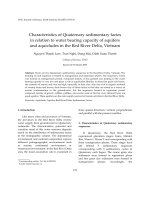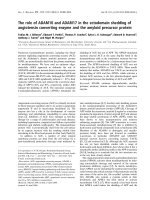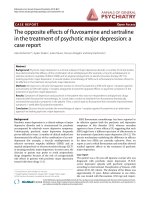Costs of Migration and Operation in the Cloud
Bạn đang xem bản rút gọn của tài liệu. Xem và tải ngay bản đầy đủ của tài liệu tại đây (1.25 MB, 22 trang )
Costs of Migration and Operation in the Cloud
Arlene Minkiewicz, Chief Scientist
PRICE Systems, LLC
© 2013 PRICE Systems, LLC All Rights Reserved |
Decades of Cost Management Excellence
1
Agenda
Introduction
Cloud Computing
– Defined
– Benefits and Risks
Cloud Migration
Pricing in the Cloud
Cost Estimation Guidance
Wrap Up
© 2013 PRICE Systems, LLC All Rights Reserved |
Decades of Cost Management Excellence
2
Introduction
Cloud computing is a
paradigm that opens the door
for utility computing
Instead of investing in
hardware, software and
infrastructure, organizations
can access through the cloud
on an as-needed basis
Still lots of hype – some
vendors have their head
further in the clouds than
their technology
© 2013 PRICE Systems, LLC All Rights Reserved |
Decades of Cost Management Excellence
3
Introduction
Cloud computing is a notion that’s gaining traction
– Information Week forecasts $180 billion by the end of 2015
– Business insider reports that 84% Of CIOs cut application costs by moving to the
cloud
– IDC predicts that one of every seven dollars spent on packaged software, server
and storage offerings will be through the public cloud by 2015
– Gartner has predicted that “2016 will be the defining year for cloud as private
cloud begins to give way to hybrid cloud, and nearly half of large enterprises will
have hybrid cloud deployments by the end of 2017”
© 2013 PRICE Systems, LLC All Rights Reserved |
Decades of Cost Management Excellence
4
You are probably already are a cloud consumer!
© 2013 PRICE Systems, LLC All Rights Reserved |
Decades of Cost Management Excellence
5
Cloud Computing
Consumers of cloud computing access hardware, software and
networking capabilities from third party providers
The cloud can be defined as resources and applications that are
available on the Internet or other network via any device that
connects to the Internet or other network
According to National Institute of Standards and Technology
(NIST), cloud computing delivers the following…
– On demand self service
– Ubiquitous network access
– Location independent resource pooling
– Rapid elasticity
– Measured services
© 2013 PRICE Systems, LLC All Rights Reserved |
Decades of Cost Management Excellence
6
Cloud Computing
Four types of clouds
– Public cloud
– Private cloud
– Community cloud
– Hybrid cloud
© 2013 PRICE Systems, LLC All Rights Reserved |
Decades of Cost Management Excellence
7
Cloud Computing
Cloud computing offerings
include
– Software as a Service (SaaS)
• Project management
• Customer Relationship
Management (CRM)
• Human Resources (HR)
– Platform as a Service (PaaS)
• Database
• Development and Testing
• Business Intelligence
– Infrastructure as a Service (IaaS)
• Backup and Recovery
• Storage
• Computation
© 2013 PRICE Systems, LLC All Rights Reserved |
Decades of Cost Management Excellence
8
Cloud Computing Benefits
Cost savings
Agility
Scalability
On-Demand Availability
Portability
Environment
Increased Innovation
Disaster Relief
Study conducted by Deloitte 2010
© 2013 PRICE Systems, LLC All Rights Reserved |
Decades of Cost Management Excellence
9
Could Computing Risks and Challenges
Security
Reliability
Vendor Lock In
Loss of Control
Data Governance
Legal Concerns
© 2013 PRICE Systems, LLC All Rights Reserved |
Decades of Cost Management Excellence
10
Migration to Cloud
Steps for Migration
– Discovery and Analytics
• What apps to migrate
• Profile of the source environment (app, its supporting software and hardware)
– Map
• What will target (cloud) landscape look like
– Provision
• Create the physical environment (if doing IaaS)
– Migrate
• Database changes
• Code Changes
• Connection Changes
– Remediate and Test
• Functions as expected
• Performs as expected
© 2013 PRICE Systems, LLC All Rights Reserved |
Decades of Cost Management Excellence
11
Software as a Service (SaaS)
Could be completely trivial
– Sign up for Facebook, Twitter, Dropbox
May require a database migration
– For CRM, time keeping, etc.
© 2013 PRICE Systems, LLC All Rights Reserved |
Decades of Cost Management Excellence
12
Infrastructure as a Service (IaaS)
Provisioning needs to occur – physically
moving applications and supporting
software stack
Should be few compatibility issues since
user can install whatever components
they need
If resource requirements are unstable or
providers resources are inadequate –
resource management component(s) may
require development
Potential overhead associated with
familiarization with target platform
technology, installation, administration
© 2013 PRICE Systems, LLC All Rights Reserved |
Decades of Cost Management Excellence
13
Platform as a Service (PaaS)
More tight control than IaaS
Potential configuration issues
– Programming Language Compatibility – version matters!
– Database Compatibility
– Third party and other supporting components
– Graphical User Interface
© 2013 PRICE Systems, LLC All Rights Reserved |
Decades of Cost Management Excellence
14
Cloud Provider Pricing Plans
Consumption Based
Subscription Based
Market Based
Advertising Based
© 2013 PRICE Systems, LLC All Rights Reserved |
Decades of Cost Management Excellence
15
Different Consumption Based Price Models
Set Price per hour for resources
Price per hour based on memory in GB, processing units,
storage space in GB and platform
Price per transferred data in GB (either inbound, outbound or
both)
Price per quantity of queries
Price per TB of data stored
Network price per GB stored (either inbound, outbound or
both)
Bandwidth charged per GB transferred
Providers generally have one or more of these pricing models
(depending on the types of services they provide and SLAs)
© 2013 PRICE Systems, LLC All Rights Reserved |
Decades of Cost Management Excellence
16
How to choose?
© 2013 PRICE Systems, LLC All Rights Reserved |
Decades of Cost Management Excellence
17
Cost Estimation Guidance
Business first needs to determine that applications are suitable
for migration
Reasons application might not be a candidate for the cloud
– Deal with sensitive data
– Require special hardware device
– Physical configuration difficult to replicate in the cloud
– Intense requirements for bandwidth or speed – cloud might be too expensive
Once feasibility is established, next step is to decide on cloud
model and pick a provider
– Best platform for capability
– In house capability to perform migration
– Unique or special requirements
– Cost – use the calculators if other than SaaS
© 2013 PRICE Systems, LLC All Rights Reserved |
Decades of Cost Management Excellence
18
Check List for Cost Assessment
Does migration include SaaS Solutions? If so….
– Does data need to be migrated to cloud? If so….
• Is target platform database compatible with source database? If so……
– Determine the extent to which queries require modification, treat this as a software
estimation exercise
• Assess the size and complexity of the database and bandwidth to evaluate
the time for physical import of the data
Does migration include IaaS Solutions? If so….
– Are resource requirements of application stable and well
within the offerings of the cloud provider? If not…..
• Determine resource requirements for resource management component,
treat this as a software estimation exercise.
– Is the migration staff experienced with the technologies
available on the cloud platform? If not….
• Determine the amount of training and installations necessary to get the
staff and the platform ready for migrated application(s)
© 2013 PRICE Systems, LLC All Rights Reserved |
Decades of Cost Management Excellence
19
Check List for Cost Assessment (cont)
Does migration include any PaaS solutions? If so….
– Is programming language compatible with the language for the source
application? If not….
• Assess the amount of code that will require modification, treat this as a software estimation exercise
– Are there database compatibility or migration issues? If so….
• Same treatment as with SaaS as detailed previously
– Are there third party components or other supporting components that are not
compatible with the selected platform? If so….
• Assess the amount of capability that will need to be modified or created, treat this as a software
estimation exercise
– Is the GUI suitable for a cloud implementation? If not….
• Assess amount of software that will be needed to create a suitable GUI, treat this as a software
estimation exercise.
© 2013 PRICE Systems, LLC All Rights Reserved |
Decades of Cost Management Excellence
20
Conclusion
Cloud computing allows organizations to offload their IT
resource requirements and responsibilities to outside providers
It can represent significant cost savings especially to small and
medium businesses and start ups
Lack of standards make price comparisons among providers
difficult.
– All the providers have calculators to help with this
– Important to understand you requirements for processing power , storage space,
bandwidth, etc. to support decision
Migration activities need to well thought out. Considerations
include:
– Cloud Computing model (SaaS, IaaS, PaaS)
– The capability being provided
– The technology gaps between source platform and target platform
© 2013 PRICE Systems, LLC All Rights Reserved |
Decades of Cost Management Excellence
21
Questions
© 2013 PRICE Systems, LLC All Rights Reserved |
Decades of Cost Management Excellence
22









